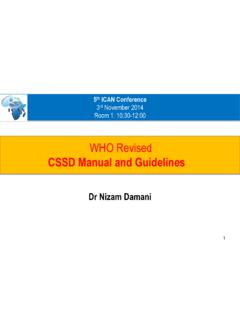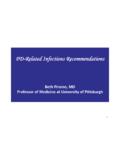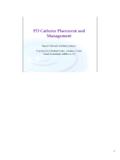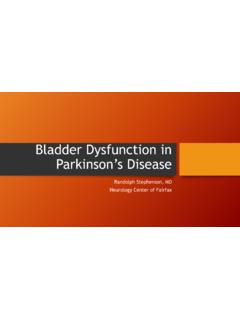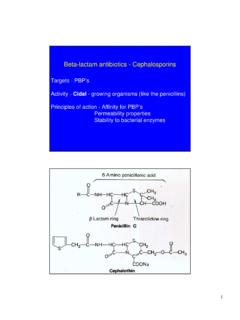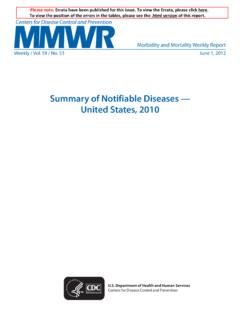Transcription of Infection Prevention and Control in Dialysis Unit
1 17-Dec-145th ICAN Conference 2014 in Harare, Zimbabwe1M O U S T A F A A B D E L N A S S E R , I C A N B O A R D M E M B E RINFECTION Prevention AND Control IN Dialysis UNITINTRODUCTION Haemodialysis(HD)and peritoneal Dialysis is a lifeline for patients with end stage renal disease (ESRD)or renal failure and are awaiting kidney transplant. Dialysis patients are at high risk of Infection because of underlying illness and numerous environmental and procedural illnesses. Establishing a comprehensive Infection Prevention and Control (IPC) program for Dialysis settings will reduce the Infection risks for both patients and healthcare workers (HCWs).17-Dec-145th ICAN Conference 2014 in Harare, Zimbabwe2 OBJECTIVE To overview the multiple infections transmitted/ induced in Dialysis patients. To stress on the essential elements of IPC program in Dialysis units. 17-Dec-145th ICAN Conference 2014 in Harare, Zimbabwe3 DEFINITIONS Central Venous Catheter (CVC): CVC is only intended for short term access use for HD in an emergency, while awaiting a fistula to heal or in preparation for a graft.
2 It carries the highest risk of Infection . Standard care procedures must be followed to reduce the risk of : A connection surgically created between an artery and vein (usually in the arm). It is accessed via a needle for HD. It has the lowest risk of Infection . Vascular graft: An artificial tube surgically placed between an artery and vein (usually in the arm). This graft is accessed via a needle for HD. It carries an intermediate risk of Infection . 17-Dec-145th ICAN Conference 2014 in Harare, Zimbabwe4 Dialysate: A balanced electrolyte solution which is introduced on one side of the semi-permeable dialysermembrane (opposite to the patient s blood) to exchange solutes with blood during HD. Dialysis water: Purified water that is used to mix the dialysate or to disinfect, rinse, or reprocess the dialyser. Dialyser: A part of the HDmachine; it has two sections separated by a membrane. The patient s blood flows through one side and the dialysate flows through the other side.
3 17-Dec-145th ICAN Conference 2014 in Harare, Zimbabwe5 DEFINITIONS (CONT )Reverse osmosis (RO): A process used to purify Dialysis water by removing dissolved inorganic solutes as well as bacteria and their Dialysis (PD) : PDinvolves Dialysis fluid instilled via a surgically inserted PDcatheter into the peritoneal space of the abdomen. Most catheters are made from silicone. The fluid is removed, taking with it any toxins. Most common types of PDinclude chronic ambulatory, continuous cyclical and chronic intermittent PD. 17-Dec-145th ICAN Conference 2014 in Harare, Zimbabwe6 DEFINITIONS (CONT )17-Dec-145th ICAN Conference 2014 in Harare, Zimbabwe7 UNDERLYING DISEASES OR CONDITIONS PRECIPITATING TO infections IN Dialysis PATIENTS Diabetes Hypertension Cardiovascular disease Immunosuppressive therapy Other critical diseases Direct access into normally sterile areas. Contamination:at various steps in the Dialysis procedure (extrensic) or of any of the components of the Dialysis system(intrinsic).
4 17-Dec-145th ICAN Conference 2014 in Harare, Zimbabwe8 THE MOST COMMON TYPES OF Dialysis -ASSOCIATED infections Access site infections Bacteremias Peritonitis Pyrogenic reactions infections with blood-borne pathogens17-Dec-145th ICAN Conference 2014 in Harare, Zimbabwe9 Infection -ASSOCIATED RISKS Hepatitis B Hepatitis C Acquired immune defi ciency syndrome (AIDS) Bacterial disease Fungi Mycobacteria 17-Dec-145th ICAN Conference 2014 in Harare, Zimbabwe10 HEPATITIS B Hepatitis B virus (HBV) is transmitted through percutaneous or permucosalexposure to the blood of infected patients (HBsAg-positive or HBeAg-positive). HBV remains viable at room temperature for at least 7days HBV has been detected on: clamps, scissors, and external surfaces and parts of Dialysis machines. HBV can be transmitted to patients or staff on gloves or unwashed ICAN Conference 2014 in Harare, Zimbabwe11 HEPATITIS C HCV is transmitted by percutaneous exposure to infected blood.
5 Factors that increase HCV Infection in HD patients of blood transfusions, of blood transfused, and on HD. IPC practices. Transmission of HCV through: equipment and supplies not disinfected between patients, of common medication carts, multi-dose medication vials, HD machines, related equipment & blood ICAN Conference 2014 in Harare, Zimbabwe12 ACQUIRED IMMUNE DEFICIENCY SYNDROME (AIDS) Human immunodeficiency virus (HIV) is transmitted by blood or blood-containing body fluids. There have been very few reports of HIV transmission in Dialysis and these resulted from inadequate disinfection of equipment, including access. 17-Dec-145th ICAN Conference 2014 in Harare, Zimbabwe13 BACTERIAL DISEASE Increased risk of Infection and colonisationwith multi-drug resistant organisms (MDRO), such as Staphylococcus aureus (MRSA) and vancomycin-resistant enterococci (VRE). Vancomycinuse is high in Dialysis populations. Outbreaks of MRSA in some Dialysis units from colonised\infected patients.
6 MDR Gram-negative infections as Pseudomonas aeruginosa, Stenotrophomonasmaltophilia, and Acinetobacterspp17-Dec-145th ICAN Conference 2014 in Harare, Zimbabwe14 MYCOBACTERIA Reports of mycobacterial infections in Dialysis patients from contaminated water. High-risk for progression from latent tuberculosis to active TB disease. Frequent hospitalisationof Dialysis patients increases the risk of transmission of TB to other patients or to ICAN Conference 2014 in Harare, Zimbabwe15 FUNGI Dialysis patients are susceptible to fungal infections such as Aspergillusspp. In addition, there is a risk of Candida bacteraemiaand peritonitis with the patient s skin as a ICAN Conference 2014 in Harare, Zimbabwe1617-Dec-145th ICAN Conference 2014 in Harare, Zimbabwe17 Basic Principles of IPC in Dialysis Unit1-SURVEILLANCER outine testing / or documentation for: HBV , HCV & HIV as soon as, it is anticipated that Dialysis is required & every 3 months, for : HBsAg, HCV & HIV antibody Patient s vaccination ( HBV).
7 Bacteraemia, access site infections , and peritonitis. Treatment station used and machine number, as well as namesof staff connecting and disconnecting the patient. This information will be useful in any outbreak ICAN Conference 2014 in Harare, Zimbabwe182-STANDARD AND TRANSMISSION-BASED PRECAUTIONS Segregation of HBsAg-positive patients and their equipment and supplies from those used for non-HBV-infected patients. Patients with either HCV or HIV Infection also require a dedicated machine. Contact Precautions for MDRmicroorganisms, such as MRSA and VRE, and Gram negative ICAN Conference 2014 in Harare, Zimbabwe192-STANDARD AND TRANSMISSION-BASED PRECAUTIONS (CONT ) Proper hand hygiene (HH) (as WHO s 5 moments). Staff must wear a mask and gloves and the patient must wear a mask while the site is being accessed. Wash the access site using an antibacterial soap/scrub and water. Cleanse the skin by 2% chlorhexidine gluconate/70% isopropyl alcohol, 70% alcohol, or 10% povidoneiodine.
8 Access lines used for HD must not be used for other ICAN Conference 2014 in Harare, Zimbabwe203-ENVIRONMENTAL CLEANING AND DISINFECTION Hospital grade disinfectant is used for all patient areas. Special attention to high-touch items or surfaces likely to be contaminated with blood or body fluids. Prompt containment and cleaning of spills of blood or body fluids. Prevention of mouldcontamination resulting from water damage or wetting of permeable walls, furniture, etc. Strict adherence to IPC precautions for construction and renovation activities Used supplies and dialysersshould be disposed of to prevent contamination of patients and environmental surfaces. 17-Dec-145th ICAN Conference 2014 in Harare, Zimbabwe214-EQUIPMENT CLEANING AND DISINFECTION Policies and procedures for correct care and maintenance of, Dialysis systems, including the water treatment system, distribution system, and Dialysis machines. Reusable dialysersmust be cleaned, receive high-level disinfection, and be thoroughly rinsed and dried prior to reuse.
9 Adequate cleaning and disinfection of Dialysis machines and equipment and reusable supplies between all patient ICAN Conference 2014 in Harare, Zimbabwe225-SAFE MEDICATION AND INJECTION PRACTICES Avoid contamination of multi-dose vials. The stopper should be disinfected with alcohol before accessing the vial. A single use sterile needle and syringe for each access. Single-use vials are preferable. Needles should not be recapped. Used sharps should to be discarded sharps containers. Safety engineered medical devices ( , self-retracting or self sheathing needles) when ICAN Conference 2014 in Harare, Zimbabwe236-PATIENT IMMUNISATION, POST-VACCINATION TESTING, AND SCREENING Screen for HBV prior to start of HD treatment. Immunisefor HBV. Testing for HBV one to two months after the primary vaccinations. Annual testing for antibody to HBsAg. A booster dose should be administered when anti-HBs levels decline to <10 mIU/ml. Dialysis patients younger than 65 years ---------a dose of pneumococcal vaccine followed by a dose every 5 years.
10 If over 65 years, only one dose of vaccine is required. Screening of patients for MRSA or VRE is only necessary in outbreak or suspected ICAN Conference 2014 in Harare, Zimbabwe247-PATIENT AND HCWSEDUCATION The staffshould receive initial and on-going education on the basic principles and practices of Dialysis , infectious risks and potential adverse events, and IPC practices. The patient should receive education on access site and dressing care, signs and symptoms of Infection , and the importance of reporting potential infections . 17-Dec-145th ICAN Conference 2014 in Harare, Zimbabwe258-OCCUPATIONAL SAFETY CONSIDERATIONS Standard Precautions and, as necessary, transmission-based precautions, PPEand HH to protect from blood or body fluids. Gloves, masks, and gowns must be used when connecting and disconnecting Dialysis patients during the Dialysis process. Routine testing of staff for HCV, HBV, or MDRO is not recommended. Staff should receive hepatitis B ICAN Conference 2014 in Harare, Zimbabwe269-WATER TREATMENT AND TESTING Testing of Dialysis water and dialysate at least monthly as per the US Association for the Advancement of Medical Instrumentation (AAMI) guidelines.
